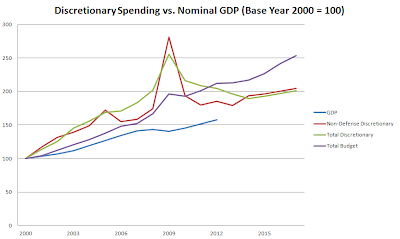As you can see, government spending has dwarfed the growth in the economy since 2000 with even non-Defense discretionary spending up a whopping 85% since then compared to growth in nominal GDP of 57.5% (so no blaming the wars in Iraq and Afghanistan). The sequester cuts barely even register as blips on these spending growth curves with total federal spending continuing to climb after these supposedly "draconian" cuts.
So all the scare tactics that seem to imply that aircraft will drop from the skies, cops and FBI agents will be let go and children will die from lack of vaccinations are just a bunch of BS. As everyone who has been to a government office knows, there is plenty of slack in government with government workers being paid more to do less than private sector counterparts. Check out this list of common sense cuts from Rand Paul that won't cause anyone to lose their jobs:
• Stop Hiring New Federal Employees:
$6.5 billion saved annually
Every
year, thousands of federal employees retire or leave their jobs. In 2011,
roughly 62,000 people ended their careers with the government. Estimates vary,
but allowing a federal bureaucrat to retire without replacing that person with
another employee can save anywhere from $60 billion to $200 billion over 10
years. This provision estimates to save $6.5 billion in one year.
•· Bring Federal Employee Pay in Line
With Private Jobs: $32 billion saved annually
According
to the Congressional Budget Office, the average compensation of a federal employees
is 16 percent more than their private equivalents. By reducing salaries to
align more with their private counterparts, this provision could save as much
as $32 billion a year.
•· Reduce Federal Employee Travel by 25
Percent: $2.25 billion saved annually
The
latest data provided by the General Services Administration suggested that the
federal government spent $9 billion on travel. Reducing the federal travel
budget by at least 25 percent can reduce the budget by $2.25 billion a year.
•· Focus Military Research on Military
Needs: $6 billion saved annually
According
to research done by the staff of Sen. Tom Coburn (R-Okla.), found that the
Defense Department spent $6 billion on research that had nothing to do
with military or military-related health inquires.
•· Require Competitive Bidding for
Government Contracts: $19 billion saved annually
The
Davis-Bacon prevailing wages law
requires federal projects to pay the employees higher wages. This would repeal
this requirement and allow the government to save money by making pay
competitive to all government employees. The Heritage Foundation estimates that
this will save $9 billion a year. Also,
many contracts in the federal government are provided to
companies without requiring a competitive bid - or the opportunity for the
government to contract work at the lowest price possible. This provision would
require the government to competitively bid all contracts. This provision would
save an additional $10 billion a year.
•· Cut 50 Percent of Foreign Aid: $20
billion saved annually
We spend
more than $40 billion a year on foreign aid. When we're dealing with a budget
crisis here at home, it's only responsible to bring this money home. This
provision would eliminate half the foreign aid budget.

No comments:
Post a Comment